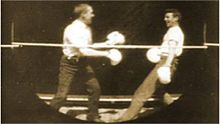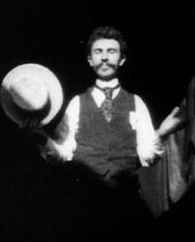
William Kennedy Laurie Dickson was a British-American inventor who devised an early motion picture camera under the employment of Thomas Edison.
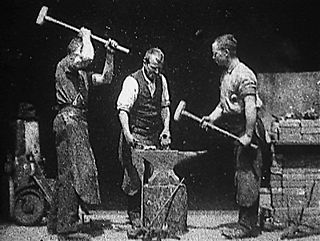
Blacksmith Scene is an 1893 American short black-and-white silent film directed by William K.L. Dickson, the Scottish-French inventor who, while under the employ of Thomas Edison, developed one of the first fully functional motion picture cameras. It is historically significant as the first Kinetoscope film shown in public exhibition on May 9, 1893, and is the earliest known example of actors performing a role in a film. It was also the first U.S. motion picture film ever copyrighted that same year. 102 years later, in 1995, Blacksmithing Scene was selected for preservation in the United States National Film Registry by the Library of Congress as being "culturally, historically, or aesthetically significant". It is the second-oldest film included in the Registry, after Newark Athlete (1891).
The following is an overview of the events of 1895 in film, including a list of films released and notable births.
The following is an overview of the events of 1894 in film, including a list of films released and notable births.
The following is an overview of the events of 1892 in film, including a list of films released and notable births.
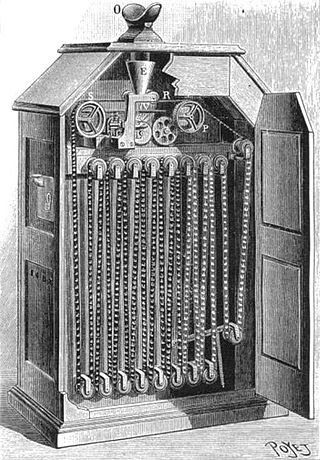
The Kinetoscope is an early motion picture exhibition device, designed for films to be viewed by one person at a time through a peephole viewer window. The Kinetoscope was not a movie projector, but it introduced the basic approach that would become the standard for all cinematic projection before the advent of video: it created the illusion of movement by conveying a strip of perforated film bearing sequential images over a light source with a high-speed shutter. First described in conceptual terms by U.S. inventor Thomas Edison in 1888, it was largely developed by his employee William Kennedy Laurie Dickson between 1889 and 1892. Dickson and his team at the Edison lab in New Jersey also devised the Kinetograph, an innovative motion picture camera with rapid intermittent, or stop-and-go, film movement, to photograph movies for in-house experiments and, eventually, commercial Kinetoscope presentations.
The following is an overview of the events of 1891 in film, including a list of films released and notable births.

Dickson Greeting is an 1891 American short silent film. Directed, produced by, and starring motion-picture pioneer William K. L. Dickson, it displays a 3-second clip of him passing a hat in front of himself, and reaching for it with his other hand. It was filmed on May 20, 1891 in the Photographic Building at Edison's Black Maria studio, West Orange, New Jersey, in collaboration with Thomas Edison using his kinetograph. The film was played for viewers at the National Federation of Women's Clubs, one of the first public presentations of a motion picture.

The Dickson Experimental Sound Film is a film made by William Dickson in late 1894 or early 1895. It is the first known film with live-recorded sound and appears to be the first motion picture made for the Kinetophone, the proto-sound-film system developed by Dickson and Thomas Edison. The film was produced at the "Black Maria", Edison's New Jersey film studio. There is no evidence that it was ever exhibited in its original format.

Edison Studios was an American film production organization, owned by companies controlled by inventor and entrepreneur, Thomas Edison. The studio made close to 1,200 films, as part of the Edison Manufacturing Company (1894–1911) and then Thomas A. Edison, Inc. (1911–1918), until the studio's closing in 1918. Of that number, 54 were feature length, and the remainder were shorts. All of the company's films have fallen into the public domain because they were released before 1928.

Actuality film is a non-fiction film genre that uses footage of real events, places, and things, a predecessor to documentary film. Unlike documentaries, actuality films are not structured into a larger narrative or coherent whole. During the era of early cinema, actualities—usually lasting no more than a minute or two and usually assembled together into a program by an exhibitor—were just as popular and prominent as their fictional counterparts. The line between "fact" and "fiction" was not as prominent in early cinema as it would become once documentaries became the predominant non-fiction filmmaking form. Actuality as a film genre is related to still photography.
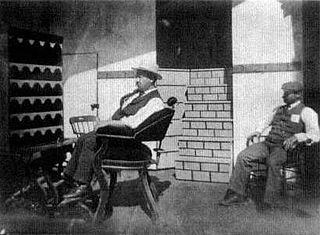
William Heise was a German-born American film cinematographer and director, active in the 1890s and credited for more than 175 short silent films. Heise filmed a "We All Smoke" skit promoting Admiral Cigarettes in 1897.

Monkeyshines is a series of experimental short silent films made to test the original cylinder format of the Kinetoscope, and are believed to be the first films shot in the United States.

Corbett and Courtney Before the Kinetograph is an 1894 American short black-and-white silent film produced by William K.L. Dickson and starring James J. Corbett. It was only the second boxing match to be filmed, following The Leonard-Cushing Fight which had been filmed by Dickson on June 14, 1894.

Buffalo Dance is an 1894 black-and-white silent film from Edison Studios, produced by William K. L. Dickson with William Heise as cinematographer. Filmed on a single reel, using standard 35 mm gauge, it has a 16-second runtime. The film, with English intertitles, was shot in Edison's Black Maria studio at the same time as Sioux Ghost Dance. These are two of the earliest films made which feature Native Americans. According to the Edison catalog, the performers in both films were Sioux people wearing traditional costumes and war paint. All were veterans of Buffalo Bill's Wild West show. Buffalo Dance has three dancers and two drummers. Hair Coat, Last Horse and Parts His Hair dance in a circle while drummers Pine and Strong Talker provide their rhythm.

Luis Martinetti, Contortionist is an 1894 American short film produced by the Edison Manufacturing Company. The film, which runs 12.5 seconds, consists of a contortionist act performed by Luis Martinetti of the Martinetti Brothers trapeze act. Martinetti wears tiger-striped tights and performs contortionist poses on a pair of trapeze rings.

Newark Athlete is an 1891 American short silent film directed and produced by William Kennedy Dickson. The film, roughly 12 seconds in length, displays a young athlete swinging Indian clubs. The identity of the athlete is unknown. It was filmed in May or June 1891, in the Photographic Building at the Edison Laboratory, West Orange, New Jersey. The firm's Black Maria studio building was not constructed until late 1892 or early 1893. The film was made to be viewed using Thomas Edison's Kinetoscope.

The Barbershop is an 1894 American short narrative silent film directed by William K.L. Dickson and William Heise. It was produced by the Edison Manufacturing Company at the Black Maria Studio, in West Orange, New Jersey. The film was one of the first created for the Kinetoscope.

The Leonard–Cushing Fight is an 1894 American short black-and-white silent film produced by William K.L. Dickson, starring Mike Leonard and Jack Cushing. Leonard and Cushing participate in a six-round boxing match under special conditions that allow for it to be filmed and displayed on a Kinetograph. The film was shot on an uncertain date between May 24 and June 14, 1894, in a specially configurated ring in Edison's Black Maria film studio in West Orange, New Jersey. Premiered on August 4, 1894 in Manhattan, the movie is the first sports film ever released. As of 2023, no full print of the film is known to have survived, making it a partially lost film. A 23-second fragment is available at the Library of Congress.

The Boxing Cats , or simply Boxing Cats, is an 1894 American short silent film directed by William K.L. Dickson and William Heise, and starring Henry Welton. It depicts a boxing match between two cats, each wearing a pair of boxing gloves. The two cats were members of Welton's touring "cat circus", which reportedly also featured cats riding bicycles.
